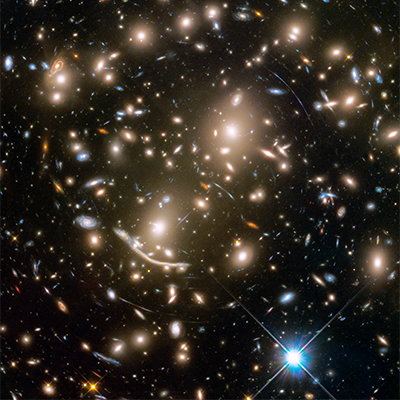Gravitational lensing is the relativistic deflection, magnification, and time dilation of signals traveling at or close to the "speed of light" through gravitational fields. It is a powerful probe of fundamental open questions, including the nature of dark matter and dark energy, the expansion history of the universe, the evolution of galaxies and compact objects, and our theory of gravity.
Our team
Academics: Professor Graham Smith, Dr Ben Gompertz
Fellows: Dr Matteo Bianconi, Dr Dan Ryczanowski
Students: Andres Ponte Perez
 Credits: NASA, ESA, J. Lotz and the HFF team
Credits: NASA, ESA, J. Lotz and the HFF team
Gravitational lensing at Birmingham
We are interested in gravitationally lensed cosmic explosions, galaxies, and their active nuclei in the distant universe, and their wide variety of messengers, including optical, infrared, and gamma radiation, gravitational waves, and potentially neutrinos. Our interests are at the interface between ongoing rapid progress in time domain astronomy, gravitational lens detection, gravitational wave detection, high energy astrophysics, high-multiplex ground-based spectroscopy, and space-based imaging of the distant universe.
Our research includes discovery of gravitational lenses, including with the Vera C. Rubin Observatory during her Legacy Survey of Space and Time (2025-2035). These lenses are being / will be discovered via the distant galaxies and transient sources (e.g. supernovae) that they magnify, and via their mass as an indicator of being capable of lensing distant sources. We have leading roles in Rubin's Strong Lensing Science Collaboration, and the LSST:UK consortium, and contribute to science validation within the Rubin Commissioning Team (SITCom). We are also helping to shape the synergy between Rubin, ESA's Euclid satellite, and ESO's 4MOST instrument for strong lens discovery.
We are particularly excited about discovering gravitationally lensed cosmic explosions, including supernovae, binary compact object mergers, and tidal disruption events. For example, in the Rubin era many predictions point to expansion of the number of lensed supernova detections growing by around two orders of magnitude. We have also shown that discovery of a gravitationally lensed binary compact object merger in electromagnetic spectrum and gravitational waves is feasible this decade -- this would be the first multi-messenger gravitational lensing discovery, and open the door to new and exciting science. A curated list of our publications relevant to multi-messenger gravitational lensing.
We also have a long-standing interest in strong and weak gravitational lensing as probes of the largescale structure of the universe, and in particular the mass and structure of galaxy clusters. The Birmingham-led Local Cluster Substructure Survey (LoCuSS) played an important role in the emergence of multi-wavelength gravitational lensing (2005-2020). We built a unique dataset on local galaxy clusters that enabled a wide range of "firsts" in galaxy cluster astrophysics and cosmology, many of which were led by early career researchers. A curated list of LoCuSS publications is available.